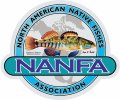Captive Care Notes: Woundfin (Plagopterus, Family Cyprinidae)
Since it is a federally endangered species, Woundfin (Plagopterus argentissimus) cannot be collected or kept in aquaria without special permission from the U.S. Fish and Wildlife Service. For those who receive such permission, Woundfin adapt well to aquaria as long as they're not overcrowded and biofiltration is adequate, according to Nevada Division of Wildlife fisheries biologist Jim Heinrich (pers. comm.). Captive specimens appear to prefer areas of current, so a submerged powerhead may be a good idea. Perhaps because of their scalelessness, woundfin are highly susceptible to Ichthyophthirious (white-spot disease, or "ich"). To prevent an outbreak, treat the water regularly with malachite green or a commercial ich curative. Woundfin will accept any aquarium fare, but since they detect food through touch rather than sight in the wild, they may initially ignore floating foods. In one laboratory setup, newly captive Woundfin milled excitedly over the bottom of their tank when food was introduced, seemingly unable to see the food above them; it took a month for most individuals to begin rising to the surface to feed.
In order to determine habitat requirements for the successful spawning of Woundfin in the wild, researchers at the University of Nevada, Las Vegas, constructed an artificial stream consisting of two concrete pools connected by two raceways. Water was pumped from one pool to the other to simulate the current. Placed in the raceways in distinct segments were four types of substrate: large rocks, small rocks, gravel, and sand. Approximately 50 adult Woundfin were collected from the Virgin River and placed into the stream. Although offered a high-protein commercial feed, they preferred the aquatic invertebrates that were present in the system. Usually the Woundfin occupied the deeper portions of the pools and swam in loosely organized schools. As April turned to May and water temperature and daylength increased, 15-20 Woundfin formed a tightly packed, wedge-shaped school and began spawning over the small rocks in the raceway. Occasionally individuals, presumably females, would leave the school and swim downstream to the lower pool. Upon each individual's return to the school the group would surround the new arrival and vibrate. Examination of the small rocks revealed the presence of adhesive eggs attached to the underside of the 5-10 cm (2-4 in) diameter rocks. After the eggs hatched, the fry sought out slower-flowing sections of the raceways, but spread out into faster-flowing currents as they grew. By documenting precisely where in the stream Woundfin spawn and where their fry and fingerlings grow, biologists know what kind of habitat must be protected in order to conserve the fish in the wild.
